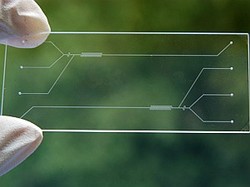A microfluidic chip-based immunoassay can detect small drug molecules in just over a minute

Fig. 1: Photograph of a microfluidic chip used in a fluorescence polarization immunoassay for detecting drugs.
c 2010 M. Tokeshi.
Immunoassays are powerful analytical techniques that exploit the specific reactions between antigens and antibodies in the immune system. They have proved to be indispensable in biological applications such as medical diagnostics and drug discovery. Now, a team led by Manabu Tokeshi and Yoshinobu Baba from the FIRST Research Center for Innovative Nanobiodevices at Nagoya University1 has developed a high-speed immunoassay method that detects analytes in about one minute using a microfluidic chip.
In addition to being costly, conventional immunoassays typically involve a number of time-consuming and complicated steps. Tokeshi and Baba addressed these problems by confining the immune reaction in a micrometer-sized channel imprinted on a glass slide (Fig. 1).
The researchers took an established technique known as fluorescence polarization immunoassay (FPIA) and adapted it to microfluidics technology. FPIA is useful for the determination of drug concentrations in blood, and works by detecting fluorescence emissions caused by small rotational changes of fluorescently labeled 'tracer' molecules that compete with antigens in binding to antibodies. The intensity of the emission increases when the concentration of free tracers rises, indicating the formation of antigen-antibody complexes.
The researchers tested the performance of their microfluidics-based FPIA by analyzing theophylline, a drug prescribed to prevent apneic attacks (arrested breathing) in premature babies and asthma attacks in adults and children.
"Monitoring the concentration of theophylline in blood is essential in any treatment for premature babies," says Tokeshi. "The drug should be monitored in the initial period of use and when combined with other drugs because of the potential for changes in its metabolism." The team constructed two test microfluidic chips and timed how long it took for theophylline to diffuse down the immunoassay microchannels and mix with the corresponding antibody. Incredibly, it took only 36 seconds for the drug to travel through the channels and bind with the antibody.
Next, the researchers found that drug concentrations in serum samples could be measured precisely and quickly using the optimized immunoassay. Solutions of theophylline, tracers and antibodies were completely mixed 65 seconds after their introduction into the microfluidic chip -- cutting down the analysis time by a factor of ten. Furthermore, the drug concentrations obtained were a close match to those produced by conventional slower methods.
"Our chip can measure the blood level of various drugs," says Baba. The team is currently running clinical trials with samples from actual patients in collaboration with the Department of Medicine at Nagoya University.
Affiliated Researchers
The Nagoya University affiliated authors mentioned in this highlight are from the FIRST Research Center for Innovative Nanobiodevices.
Reference
- Tachi,T., Kaji,N., Tokeshi, M. & Baba, Y. Microchip-based homogeneous immunoassay using fluorescence polarization spectroscopy. Lab on a Chip 9, 966-971 (2009). | article